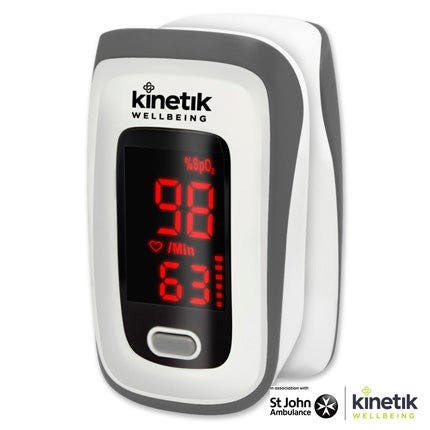Here’s what you need to know about pulse oximeters and oxygen saturation


NEW on the WW Shop: Pulse Oximeter
 This Kinetik Wellbeing Pulse Oximeter is an easy, reliable and non-invasive way to measure pulse rate and oxygen saturation levels in the blood. Completely painless and with readings that display in just a few seconds, it’s safe and convenient to use in the comfort of your own home.
This Kinetik Wellbeing Pulse Oximeter is an easy, reliable and non-invasive way to measure pulse rate and oxygen saturation levels in the blood. Completely painless and with readings that display in just a few seconds, it’s safe and convenient to use in the comfort of your own home.
Dr Ravi says...
 Ravi Assi is a qualified in-house doctor at WW UK.
Ravi Assi is a qualified in-house doctor at WW UK.
“In the current COVID-19 climate, there has been a rise in popularity of pulse oximeters. But what exactly is a pulse oximeter?
“It is an electronic device that clips onto a patient’s finger to measure heart rate and oxygen saturation in their red blood cells. It’s normally used to assess patients with lung disease, but has recently gained popularity as low oxygen saturation levels can be a sign of COVID-19.
“Furthermore, a new condition has been reported called happy hypoxia - but more precisely termed ‘silent hypoxemia’ - where people look and feel comfortable, with no shortness of breath, but their oxygen levels are dangerously low. It happens to patients both in the hospital and at home, but it’s a particular problem in the latter case because the symptom may indicate severe COVID-19-related pneumonia, which would require a ventilator. That’s why it might be useful to have the ability to monitor oxygen saturation levels at home.”1
What is pulse oximetry?
Oxygen is carried around in your red blood cells by a molecule called haemoglobin. Pulse oximetry measures how much oxygen the haemoglobin in your blood is carrying. This is called the oxygen saturation, and is a percentage (scored out of 100).2
What’s considered ‘normal’?
The oximeter display shows the percentage of oxygen in your blood. For someone who’s healthy, the normal blood oxygen saturation level will be around 95–100%.
If the oxygen level is below this, it can be an indicator that there is a lung problem.3
What is pulse oximetry used for?
The purpose of pulse oximetry is to check how well your heart is pumping oxygen through your body.
It may be used to monitor the health of individuals with any type of condition that can affect blood oxygen levels, especially while they’re in the hospital. These conditions usually include:
- Chronic obstructive pulmonary disease (COPD)
- Asthma
- Pneumonia
- Lung cancer
- Anemia
- Heart attack or heart failure
- Congenital heart defects4
Pulse oximeters are now being used to help detect ‘silent hypoxemia’ which could indicate the presence of COVID-19.5
How does a pulse oximeter work?
A pulse oximeter measures how much light is absorbed by your blood. This tells us how much oxygen your blood contains. The pulse oximeter shines two lights through your fingertip or earlobe: one red light and one infrared light.
Blood containing lots of oxygen absorbs more infrared light, and lets more red light pass through.
Blood without enough oxygen absorbs more red light, and lets more infrared light pass through. If your blood cells do not have enough oxygen, they will appear bluer.6
How can I improve my oxygen saturation readings?
Making healthy lifestyle changes can help improve your oxygen saturation levels. Healthy lifestyle changes may include:
- Revising your diet
- Exercising regularly, which can help improve lung capacity
- Losing weight, if you’re overweight
- Fixing your posture
To build up your oxygen saturation levels through diet - and help your body use oxygen more efficiently - try adding foods high in antioxidants to your diet, like blueberries, cranberries, red kidney beans, artichoke hearts, strawberries, plums and blackberries.7
Build healthy habits with WW
Our customised weight loss programme gives you the tools and motivation you need to reach a healthy weight. You’ll do this by eating more healthily, shifting your mindset and moving more, using our easy-to-use trackers in our 4.8* rated app, plus a suite of exciting features like live workouts and meditations.
These lifestyle changes may help improve your oxygen saturation levels, for example, physical activity can help improve lung capacity and oxygen saturation levels.
Dr Ravi’s top tip
“Something as simple as a change in posture can have a significant effect on breathing and oxygen intake. Simple adjustments can lead to an increase in lung capacity by roughly 5%.
“When making these adjustments, remember to stand straight, roll back the shoulders, puff out your chest, squeeze your shoulder blades and keep your chin up.”
1. https://www.atsjournals.org/doi/10.1164/rccm.202006-2157CP
2. https://www.blf.org.uk/support-for-you/breathing-tests/tests-measure-oxygen-levels
3. https://www.blf.org.uk/support-for-you/breathing-tests/tests-measure-oxygen-levels
4. https://www.blf.org.uk/support-for-you/breathing-tests/tests-measure-oxygen-levels
5. https://www.atsjournals.org/doi/10.1164/rccm.202006-2157CP
6. https://www.blf.org.uk/support-for-you/breathing-tests/tests-measure-oxygen-levels
7. https://www.medicalnewstoday.com/articles/321044
